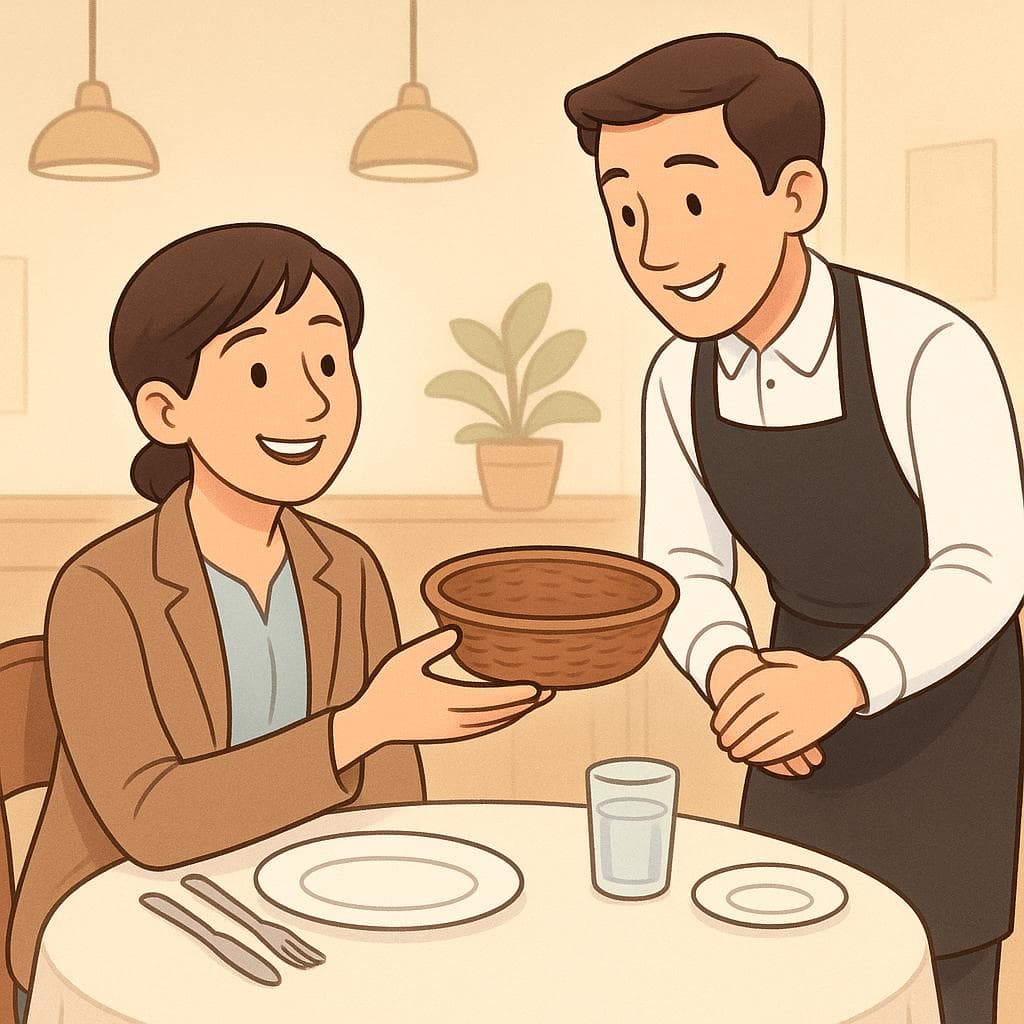Can I have more bread?
in Spanish¿Me trae un poco más de pan, por favor?
/meh TRAH-eh oon POH-koh mahs deh pahn, por fah-VOR/
This is the most standard, polite, and universally understood way to ask a waiter for more bread without being overly formal or too casual.

Visualizing the context: A polite gesture to the waiter accompanied by '¿Me trae más pan?' gets the best results.
💬Other Ways to Say It
¿Me podría traer más pan?
/meh poh-DREE-ah trah-EHR mahs pahn/
Uses the conditional tense ('could you') to make the request softer and more polite. Perfect for nice restaurants.
¿Me pones más pan?
/meh POH-nehs mahs pahn/
In Spain, the verb 'poner' (to put) is standard for serving food. It sounds direct to English speakers but is perfectly normal there.
¿Me regala un poco más de pan?
/meh reh-GAH-lah oon POH-koh mahs deh pahn/
Literally 'Gift me a little more bread,' but it doesn't mean you want it for free. It's a common politeness marker in these regions.
¿Me da más pan, por favor?
/meh dah mahs pahn, por fah-VOR/
Uses the verb 'dar' (to give). It is direct, simple, and very common in Mexico.
¿Me pasas el pan?
/meh PAH-sahs el pahn/
Means 'Pass me the bread.' This is for asking someone at your table to hand you the basket, not asking the waiter for a refill.
¿Trae más pan?
/TRAH-eh mahs pahn/
A shortened version often used in busy environments. It relies on tone of voice to be polite.
🔑Key Words
Key Words to learn:
📊Quick Comparison
Different verbs are used to ask for bread depending on where you are and how polite you want to be.
| Phrase | Formality | Best For | Avoid When |
|---|---|---|---|
| ¿Me trae...? | Neutral/Polite | Universal travel, any restaurant | Never (it's always safe) |
| ¿Me pone...? | Casual/Standard | Spain (bars, cafes) | Formal dining in Latin America |
| ¿Me regala...? | Polite/Regional | Colombia, Costa Rica | Spain (might be confusing/literal) |
| ¿Me da...? | Direct/Neutral | Mexico, fast service | Very fancy formal dinners (can sound blunt) |
📈Difficulty Level
Generally easy, though rolling the R in 'trae' or 'regala' can be tricky for beginners.
Requires using an object pronoun ('me') before the verb, which is different from English syntax.
Knowing whether to use 'poner', 'traer', or 'regalar' depends on the country, though 'traer' works everywhere.
Key Challenges:
- Remembering not to use 'tener' (to have)
- Regional verb choice (poner vs traer)
💡Examples in Action
Perdón, ¿me trae un poco más de pan, por favor?
Excuse me, could you bring me a little more bread, please?
Jefe, ¿me pones otra de pan cuando puedas?
Boss (friendly term), put another (serving) of bread for me when you can?
Amiga, ¿me regalas más pancito?
Friend, could you give me some more bread? (using diminutive for politeness)
Mamá, ¿me pasas el pan?
Mom, can you pass me the bread?
🌍Cultural Context
The 'Cubierto' in Spain
In Spain and parts of Europe, bread is often not free. You might see a charge on your bill called 'cubierto' (cover) or simply 'pan'. If you ask for *more* bread, you might be charged for a second serving, so don't be surprised if it appears on the check!
The Sweetness of 'Regalar'
In countries like Colombia, Costa Rica, and parts of Guatemala, using the verb *regalar* (to gift) is a standard way to soften a request. Asking '¿Me regala un café?' doesn't mean you want a free coffee; it's just a polite way of saying 'sell me a coffee' or 'bring me a coffee.'
Bread vs. Tortillas
In Mexico and Central America, the 'bread basket' might actually be a tortilla warmer. The phrase changes slightly to '¿Me trae más tortillas?' but the structure remains exactly the same.
❌ Common Pitfalls
The 'Can I Have' Trap
Mistake: "Saying '¿Puedo tener más pan?'"
Correction: ¿Me trae más pan?
Forgetting the 'Me'
Mistake: "Saying simply 'Trae pan' or 'Da pan'"
Correction: ¿Me trae pan?
💡Pro Tips
Use 'Un Poco' to Sound Polite
Adding 'un poco' (a little) before 'más de pan' makes you sound less demanding. Instead of 'I want more bread,' you are saying 'Bring me a little more bread,' which feels more humble and polite.
Get Attention First
Before launching into the phrase, establish eye contact or raise your hand slightly and say 'Perdón' (Excuse me) or 'Disculpe' (Formal excuse me) to the waiter. Then make your request.
🗺️Regional Variations
Spain
Spaniards are often more direct. Using 'poner' (to put) is extremely common in food service. Also, remember that bread is rarely free here; it's a specific menu item or cover charge.
Mexico
Mexicans value politeness highly. While 'Me da' is common, adding 'por favor' is practically mandatory. In a taquería, you are more likely asking for tortillas than wheat bread.
Colombia
Colombian Spanish is famous for its extreme politeness. 'Regalar' (gift) and even 'colaborar' (collaborate/help) are used to ask for service items.
💬What Comes Next?
The waiter brings the bread
Aquí tiene / Aquí está
Here you go / Here it is
Muchas gracias, muy amable
Thank you very much, very kind
They ask if you want anything else
¿Algo más?
Anything else?
No, solo eso por ahora
No, just that for now
🧠Memory Tricks
The verb *Traer* sounds like 'Tray-er'. When you want the waiter to bring something on a TRAY, use TRAE-r.
🔄How It Differs from English
English speakers focus on their own ability to receive ('Can I have...'), while Spanish speakers focus on the other person's action ('Will you bring me...'). This shift from 'having' to 'bringing/giving' is the biggest mental hurdle.
False Friends & Common Confusions:
Why it's different: Translating this literally to '¿Puedo tener?' sounds like you are asking if you have the physical capability to own bread.
Use instead: ¿Me trae...? (Does he/she bring me?)
🎯Your Learning Path
➡️ Learn Next:
How to ask for the bill in Spanish
Once you finish eating that extra bread, you'll need to pay.
How to order water in Spanish
Another essential table request that uses the same verb structures.
How to say I am full in Spanish
Useful if you eat too much of the bread you just ordered!
✏️Test Your Knowledge
💡 Quick Quiz: Can I have more bread?
Question 1 of 3
You are in a tapas bar in Madrid. What is the most natural way to ask the bartender for more bread?
Frequently Asked Questions
Is bread free in Spanish restaurants?
It depends on the region. In Mexico and many parts of Latin America, bread or tortillas are usually complimentary. In Spain and parts of Europe, you will often see a small 'cubierto' or 'pan' charge on the bill for each person.
Can I just say 'Más pan, por favor'?
Yes, absolutely. If you are struggling with the verbs, saying 'Más pan, por favor' (More bread, please) is perfectly understood and polite enough for casual situations, as long as you smile!
How do I ask for butter to go with the bread?
You can use the same structure: '¿Me trae mantequilla, por favor?' (Could you bring me butter, please?).
What if I want different bread, not just more of the same?
You could ask, '¿Tienen otro tipo de pan?' (Do you have another type of bread?).
📚Continue Learning Spanish Phrases
Explore More Phrases in These Categories
Find similar phrases to expand your Spanish vocabulary:
Want to Learn More Spanish Phrases?
Browse our complete collection of Spanish phrases organized by situation, from basic greetings to advanced conversations. Perfect for travelers, students, and anyone learning Spanish.
View All Spanish Phrases →

